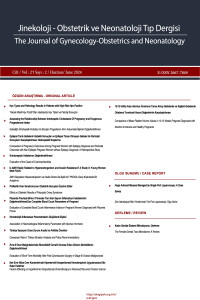Öz
Aim: We aimed to analyses the high-risk HPV type distribution and pathology results in high-risk HPV positive patients.
Materials and Methods: The research was retrospectively conducted and data was obtained from a tertiary gynecologic oncology colposcopy outpatient clinic. From September 2019 to December 2022, data from 3546 patients who tested positive for HPV and underwent colposcopic examination were analyzed. All patients granted the institution explicit permission to utilize their clinical data.
Results: A total of 3546 patients with a median age of 40 years (range, 18–77 years) were analysed. Patient’s HPV status was; 1169 (33%) patients were HPV 16, 343 (9.7%) patients were HPV 18, and 2318 (65.4%) patients were HPV others. The detailed HPV positive results of patients were that 888 (25.4%) patients were only HPV 16, 197 (5.6%) patients were only HPV 18, and 2097 (59.9%) patients were only HPV others. In the study cohort, 529 (14.9%) patients had CIN 2+ lesions. HPV 16 and/or HPV 18 were detected in 331 (62.5%) of 529 patients with CIN 2+ lesions. The final pathology result of 507 (14.3%) patients was CIN 2/3 and of 22 (0.6%) patients was cancer.
Conclusion: In conclusion, we found that while HPV other types were positive in two-thirds of the patients, HPV 16 and/or 18 were positive in more than four-fifths of the cancer cases. In the high-risk HPV positive patient group, HPV type can be used as a criterion when referring the patient to colposcopy
Anahtar Kelimeler
Kaynakça
- 1. virus infections: Epidemiology and disease associations. Walt- ham: UpToDate. 2018. Palefsky JM, Hirsch M, Bloom A. Human papilloma- 2. Solomon D, Davey D, Kurman R, Moriarty A, O’Connor D, Prey M, et al. The 2001 Bethesda System: terminology for reporting results of cervical cytology. Jama. 2002;287(16):2114- 9. 3. Nayar R, Wilbur DC, Nayar R, Wilbur D. The Pap Test and Bethesda 2014. Journal of the American Society of Cyto- pathology. 2015;3(4):170-80.
Öz
Amaç: Yüksek riskli HPV pozitif hastalarda yüksek riskli HPV tipi dağılımını ve patoloji sonuçlarını analiz etmeyi amaçladık.
Materyal ve Metot: Araştırma retrospektif olarak yürütülmüş olup veriler üçüncü basamak bir jinekolojik onkoloji kolposkopi polikliniğinden elde edilmiştir. Eylül 2019'dan Aralık 2022'ye kadar HPV testi pozitif çıkan ve kolposkopik muayene yapılan 3546 hastanın verileri analiz edildi. Tüm hastalar kuruma klinik verilerinin kullanılması için açık izin verdi.
Bulgular: Ortanca yaşı 40 (aralık, 18-77 yıl) olan toplam 3546 hasta analiz edildi. Hastanın HPV durumu; Hastaların 1169'u (%33) HPV 16, 343'ü (%9,7) HPV 18 ve 2318 (%65,4) hasta HPV diğerleri idi. Hastaların ayrıntılı HPV pozitif sonuçları, 888 (%25,4) hastanın yalnızca HPV 16, 197 (%5,6) hastanın yalnızca HPV 18 ve 2097 (%59,9) hastanın yalnızca HPV diğerleri olduğu şeklindeydi. Çalışma grubunda 529 (%14,9) hastada CIN 2+ lezyon vardı. CIN 2+ lezyonlu 529 hastanın 331'inde (%62,5) HPV 16 ve/veya HPV 18 tespit edildi. 507 (%14,3) hastanın nihai patoloji sonucu CIN 2/3, 22 (%0,6) hastanın ise kanser olduğu belirlendi.
Sonuç: Sonuç olarak, HPV'nin diğer tipleri hastaların üçte ikisinde pozitif iken, HPV 16 ve/veya 18'in kanser vakalarının beşte dördünden fazlasında pozitif olduğunu bulduk. Yüksek riskli HPV pozitif hasta grubunda hastayı kolposkopiye yönlendirirken HPV tipi kriter olarak kullanılabilir.
Anahtar Kelimeler
Kaynakça
- 1. virus infections: Epidemiology and disease associations. Walt- ham: UpToDate. 2018. Palefsky JM, Hirsch M, Bloom A. Human papilloma- 2. Solomon D, Davey D, Kurman R, Moriarty A, O’Connor D, Prey M, et al. The 2001 Bethesda System: terminology for reporting results of cervical cytology. Jama. 2002;287(16):2114- 9. 3. Nayar R, Wilbur DC, Nayar R, Wilbur D. The Pap Test and Bethesda 2014. Journal of the American Society of Cyto- pathology. 2015;3(4):170-80.
Ayrıntılar
| Birincil Dil | İngilizce |
|---|---|
| Konular | Kadın Hastalıkları ve Doğum |
| Bölüm | Araştırma Makaleleri |
| Yazarlar | |
| Yayımlanma Tarihi | 30 Haziran 2024 |
| Gönderilme Tarihi | 16 Mart 2024 |
| Kabul Tarihi | 2 Mayıs 2024 |
| Yayımlandığı Sayı | Yıl 2024 Cilt: 21 Sayı: 2 |

